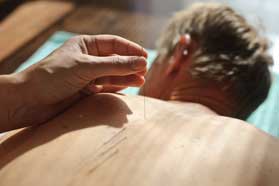Dry Needling in Glendale, CA

What Is Dry Needling?
The fascia or myofascia are taut bands of tissue that surround your muscles and bones. Myofascial pain often results from muscle injury or repetitive strain. When stressed or injured, muscles often form myofascial trigger points, like contracted knots, that cause pain and tightness. In individuals suffering from musculoskeletal conditions, these trigger points can become tender when pressure is applied, and may radiate and cause pain in other areas of the body.
Dry needling is an innovative pain relief technique used by healthcare practitioners to treat myofascial trigger points. The goal of dry needling is to inactivate trigger points and induce a healing response to reduce pain and improve range of motion. Research has demonstrated that dry needling reduces pain and muscle tension and improves nerve impulse transmission to muscles. When coupled with physical therapy, dry needling can enhance the rehabilitation process significantly.
If you experience myofascial pain, relief is possible with non-invasive dry needling treatments. To schedule a consultation with a healthcare practitioner in Glendale who specializes in dry needling, call (424) 365-1800 or contact Vitality Integrative Medicine online.
How Does Dry Needling Therapy Work?
When injury occurs in the body, the muscles become inflamed, causing pain. The body's natural defensive response can create scar tissue, and the muscles remain in a constant state of contraction. The combination of pain and muscle injury in one area can limit one's mobility, putting stress on other joints in the body. Over time, muscle injury in one area can negatively impact other regions of the body.
During dry needling, your healthcare provider inserts thin filament needles directly into the tight or painful muscle area(s). When the needle is inserted, an involuntary reflex occurs, known as a local twitch response. This involuntary reflex helps reset the dysfunctional muscle by dissipating the spontaneous electrical activity that occurs in injured muscle tissue. The procedure helps quiet the muscle and allows it to restore its normal function. As the muscle returns to its natural state, the pain and inflammatory signals in the body subside, resulting in healing with decreased pain and inflammation. The decrease in tension and muscle contraction also leads to improved mobility and range of motion.
Dry Needling vs. Acupuncture
Both dry needling and acupuncture use similar solid filament needles; however, the objective of each treatment differs. Acupuncture is based on traditional Chinese medicine that helps balance the flow of energy, known as Chi or Qi, by activating meridian pathways in the body. Based on one's health condition and imbalances, needles are inserted into specific points along the meridian pathways to help restore health to the body. Acupuncture can be used to address pain as well as a variety of health concerns.
Dry needling does not follow the Chinese medicine philosophy. It is based on Western medicine and the science of neuromuscular function. The goal of dry needling is to stimulate the underlying myofascial trigger points and muscular and connective tissues. Dry needling therapy targets pain associated with musculoskeletal conditions while improving mobility and stability.
Who Can Benefit from Dry Needling?
Dry needling is used for the treatment of pain, disability, and dysfunction. It is effective for resolving soft tissue dysfunction, such as inflammation, swelling, contractures, trigger points, and various other musculoskeletal conditions.
In addition, musculoskeletal and chronic pain conditions that benefit from dry needling include:
- Myofascial pain syndrome
- Neck and back pain
- Acute and chronic injuries
- Tendonitis
- Sciatica
- Muscle spasms
- Hip and knee pain
- Muscle strains
- Tennis and golfer’s elbow
- Runner’s knee
- Carpal tunnel syndrome
- Headaches and migraines
- Jaw pain
- Hamstring sprains
- Multiple sclerosis
Is Dry Needling Painful?
The dry needling procedure itself is not painful. Very minor discomfort occurs when the needles are inserted. The muscles may be sore after the initial session--similar to the soreness observed following an intense workout. The pain dissipates after the first day and as muscle function is restored, future treatments become much more comfortable.
How Many Dry Needling Sessions Are Required?
Typically, a minimum of three dry needling sessions spread out over a period of a week are required; this gives the muscles time to recover. When progress is observed, the treatments may be spread out over the course of a few weeks, or once per month.
The extent of the dry needling sessions required depends on the individual's situation. Most patients require an average of six to eight sessions for optimal recovery. For minor and acute injuries, one treatment session may suffice. Chronic injuries require a greater number of sessions to restore movement and muscular function.
Dry Needling Therapy Results
Many patients experience a decrease in pain and an increase in motion following the first treatment; however, individual results may vary.
In addition to reducing pain and improving mobility, dry needling helps the body to regain its full strength, decreasing the risk of injury when one resumes normal activities and exercise. Dry needling can also help lengthen the muscle which is ideal for athletes who are searching for ways to naturally enhance their performance.
Dry needling requires little to no downtime, does not have side effects and has helped many individuals discontinue their pain medications. Dry needling offers a natural and sustainable solution for musculoskeletal pain that is much less expensive and invasive than steroid injections or surgery.
If you experience myofascial pain and want a natural treatment solution, ask an experienced pain relief practitioner about dry needling therapy in Glendale. Call (424) 365-1800 or contact Vitality Integrative Medicine online.
Vitality Integrative Medicine
Address
4849 Van Nuys BlvdSuite 104
Sherman Oaks, CA 91403
(424) 365-1800
www.vitalityintegrative.com
Hours
Mon:
8:00 am - 6:00 pm
Tue:
8:00 am - 6:00 pm
Wed:
8:00 am - 6:00 pm
Thu:
8:00 am - 6:00 pm
Fri:
8:00 am - 6:00 pm
Sat:
8:00 am - 12:00 pm
